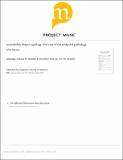Learnability Shapes Typology: The Case of the Midpoint Pathology
Author(s)
Stanton, Juliet
DownloadStanton-2016-Learnability shapes typology_ The.pdf (7.351Mb)
PUBLISHER_POLICY
Publisher Policy
Article is made available in accordance with the publisher's policy and may be subject to US copyright law. Please refer to the publisher's site for terms of use.
Terms of use
Metadata
Show full item recordAbstract
The midpoint pathology (in the sense of Kager 2012) characterizes a type of unattested stress system in which the stressable window contracts to a single word-internal syllable in some words, but not others. Kager (2012) shows that the pathology is a prediction of analyses employing contextual lapse constraints (e.g. *ExtLapseR; no 000 strings at the right edge) and argues that the only way to avoid it is to eliminate these constraints from Con. This article explores an alternative: that systems exhibiting the midpoint pathology are unattested not because the constraints that would generate them are absent from Con, but because they are difficult to learn. This study belongs to a growing body of work exploring the idea that phonological typology is shaped by considerations of learnability.*
Date issued
2016-12Department
Massachusetts Institute of Technology. Department of Linguistics and PhilosophyJournal
Language
Publisher
Muse - Johns Hopkins University Press
Citation
Stanton, Juliet. “Learnability Shapes Typology: The Case of the Midpoint Pathology.” Language 92.4 (2016): 753–791.
Version: Final published version
ISSN
1535-0665